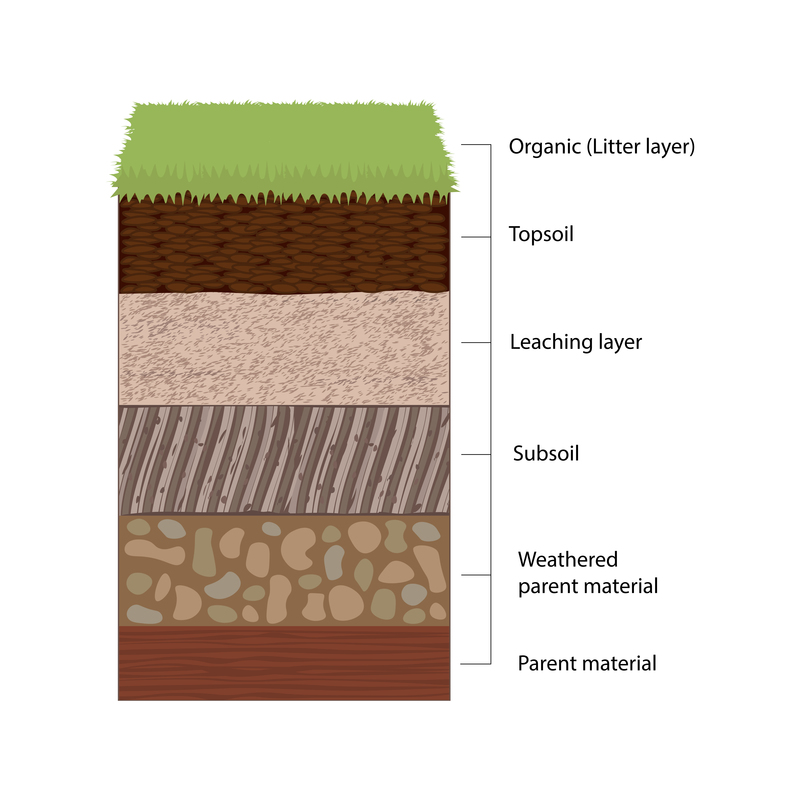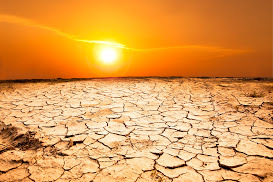Factsheet
Soil
Far from being just ‘dirt’ or ‘mud’ beneath our feet, soil is one of the most diverse ecosystems on our planet. Healthy soil is a life support system for much of the life on Earth.
What is Soil?
Sometimes described as the ‘skin of the earth’, soils are mixtures of minerals, organic matter, water and air together with countless organisms andthe decaying remains of once-living things. There are three main types of soil:
Sand is actually small grains of rock, worn away over time by weather. Sand grains range from 0.05 mm to 2 mm, so you can see them and feel them if you rub them between your fingers. Sandy soil isn’t very good at holding water or nutrients in it, so it isn’t very useful for growing plants.
Silt feels a bit like a powder and can be thought of as a very fine sand. It will hold water quite well compared with sand, but still not really enough to make it useful for growing plants. Silt grains are between 0.002 and 0.005mm wide! You’d have to use a magnifying glass if you wanted to make out those individual grains.
Clay has the smallest particles with individual grains measuring less than 0.002mm across. A gram of coarse sand contains about 1000 grains, but a gram of clay contains about 90 billion of them! Clay is very good at holding nutrients and water. It forms shapes well, which is why it is used to make objects such as cups and plates.
Other types of soil are mixtures of these three types. Loam is a mix of all three of the above and is useful for gardening because it holds nutrients well, but is also good at draining away excess water.
 If you were to dig a slice of the ground out from anywhere on Earth, you’d eventually hit rock. This slice of the ground would give you a ‘soil profile’ showing all the layers of the soil.
If you were to dig a slice of the ground out from anywhere on Earth, you’d eventually hit rock. This slice of the ground would give you a ‘soil profile’ showing all the layers of the soil.
The very top might have organic matter, such as grass growing on it. It might have a layer of ‘leaf litter’ This can be a thick or thin layer, or it may not exist at all in some places. Next, you get to the topsoil. A clay and mineral layer follows, then the subsoil before you arrive at the rocky deposits beneath.
Why is Soil so Important?
Soil is vital to life on Earth. Without healthy soil, plants cannot grow. The food that we grow to eat and the plants that animals eat all depend on the soil. Organisms that live in the soil depend on it as a habitat. These organisms include bacteria and fungi that help to break down decaying matter so that when a living thing dies, its remains can be ‘recycled’ back into the ecosystem.
In a healthy topsoil rich with nutrients, a single gram could contain as many as 75,000 species of bacteria, 25,000 species of fungi, 1,000 species of protozoa (single celled microscopic organisms), and several hundred species of nematodes (small worms). Plant roots are dependent on these tiny organisms to provide them with the nutrition that they need to grow and to resist diseases.
Soils are also able to absorb and filter water, helping to filter and purify it as it travels through the ground to rivers, or deep underground to water stores known as aquifers. Underground water is some of the purest water available as soil is able to filter out pollutants. By absorbing amounts of rain water, soil can prevent flooding.
Soil also helps protect the planet from climate change. When plants turn the sun’s light into a source of food using photosynthesis, they also absorb carbon dioxide from the air. Dead plants rot down and the carbon inside them becomes ‘sequestered’ (stored) back in the soil. Excess carbon dioxide in the atmosphere can lead to global warming, which causes climate change. By sequestering carbon away, soil helps prevent too much being in the atmosphere. After oceans, soils are the largest ‘carbon sinks’ on the planet, even beating forests in their ability to capture carbon dioxide from the air.
What is Soil Erosion and Degradation?
 According to the Food and Agricultural Organisation (FAO), it can take hundreds of thousands of years to form a healthy topsoil one centimetre deep. In certain circumstances, that centimetre of soil can be lost in a single year due to erosion.
According to the Food and Agricultural Organisation (FAO), it can take hundreds of thousands of years to form a healthy topsoil one centimetre deep. In certain circumstances, that centimetre of soil can be lost in a single year due to erosion.
Erosion is a process that occurs naturally when either rain water or wind carries away the top layer of soil. However, many human actions can speed up this process. Tillage is the term for any farming method, such as digging or ploughing, that moves soil in readiness for planting crops. These practices disturb the soil structure making it more likely to be washed or blown away.
A healthy soil, full of nutrients is better able to withstand erosion, as the soil particles are less fine. Unfortunately, many tillage practices reduce the quality of the soil. Soil that is compacted by farming, forms a hard ‘crust’ on top and this means that rain water is less likely to be absorbed. Instead, when it rains, the topsoil is washed away. A good covering of plants or trees helps to protect the soil because the roots of the plants help to keep the soil in place. When trees are cut down to plant crops, and when rows of crops are harvested, the exposed soil is less able to withstand erosion. Deforestation, the process by which tress are cut down to provide farming land, is one of the main causes of soil erosion.
Soil degradation is the term for soil being harmed so that it no longer contains a healthy mix of bacteria and other organisms. This can be caused by the use of various chemicals such as fertilisers and pesticides. As the soil becomes degraded, it is less able to avoid being eroded.
Erosion is also caused when land is built on. A covering of concrete or tarmac, such as that used in the construction of roads and buildings, means that rainwater can’t be absorbed naturally into the ground and has to run off to nearby ground in large quantities instead, flooding those areas and increasing the risk of erosion.
In 2014, a senior official at the United Nations warned that “if current rates of degradation continue all of the world's top soil could be gone within 60 years”, though a 2021 study by Oxford University disproved this.
They found that soil erosion rates span five orders of magnitude; some are eroding quickly, some very little, and others are actually thickening.
The data, based on a global assessment of 4,285 erosion estimates from 240 studies across 38 countries, revealed that:
- 16% of soils are estimated to have a lifespan of less than 100 years
- 50% have a lifespan greater than 1,000 years
- 33% have more than 5,000 years
How can we Help Protect Soil?
One of the most effective ways to improve soil quality whilst preventing erosion and protecting soil’s ability to continue functioning well, is to increase the amount of organic material being put back into the ground. There are a range of organic farming methods, which are designed to help sustain soil health, such as using fewer chemical pesticides. This means that the topsoil is not degraded so quickly. In addition, fewer chemical pesticides mean that birds and other insect-eating creatures are more likely to live on farmland, providing a degree of natural pest control.
Farming methods that cause less soil compaction help to improve the soil’s ability to absorb water, so preventing further erosion. Livestock can also be prevented from over grazing in certain areas, which both impacts the soil and removes protective plant coverage of that area.
Soil erosion can also be prevented by covering bare soil with crops that stay in leaf for longer or by practicing ‘no till farming’ allowing crops to stay in the fields for a season, meaning that the ground is not left bare. Protecting forests and planting more trees can also prevent soil erosion, as well as ensuring continued soil health. Farmers can ‘rotate’ their crops, choosing to plant a wider range of species over several growing seasons. Increased biodiversity improves the range of nutrients in the soil and helps prevent pollution caused by the need for fertilisers.
People can also act on a much smaller scale. One of the things that individuals can do to help is to reduce the amount of food that they waste. This not only reduces the amount that has to be grown in the first place, it also prevents valuable nutrients from ending up in landfill sites where they cannot benefit the soil. By composting our food and garden waste instead, these nutrients can be returned to the soil. We can also choose to use fewer chemical products such as pesticides in our gardens so that these do not damage the soil.
Credits
Foodprint, (12/4/19), What Is Soil and Why Is It Important? by Lela Nargi, (online), Available from: https://foodprint.org/blog/why-is-soil-important/, [Accessed 23/1/21]
Ontario Ministry of Agriculture, (Dec 2018), Soil Erosion – Causes and Effects, (online), Available from: http://www.omafra.gov.on.ca/english/engineer/facts/12-053.htm, [Accessed 23/1/21]
Youmatter, (21/7/2020), Soil Erosion and Degradation: Simple Definition, Causes, Consequences, (online), Available from: https://youmatter.world/en/definition/soil-erosion-degradation-definition/, [Accessed 23/1/21]
Food and Agriculture Organisation, (2015), Soils help to combat and adapt to climate changeby playing a key role in the carbon cycle, (online), Available from: http://www.fao.org/3/a-i4737e.pdf, [Accessed 23/1/21]
The Soil Association: https://www.soilassociation.org/causes-campaigns/save-our-soil/
Farmers Weekly, (2021) ‘Only 60 years of harvests left’ claim is a myth, says study, by Philip Case, (online), Available from: https://www.fwi.co.uk/news/only-60-years-of-harvests-left-claim-is-a-myth-says-study [Accessed 11/3/21]
 If you were to dig a slice of the ground out from anywhere on Earth, you’d eventually hit rock. This slice of the ground would give you a ‘soil profile’ showing all the layers of the soil.
If you were to dig a slice of the ground out from anywhere on Earth, you’d eventually hit rock. This slice of the ground would give you a ‘soil profile’ showing all the layers of the soil. 
 According to the Food and Agricultural Organisation (FAO), it can take hundreds of thousands of years to form a healthy topsoil one centimetre deep. In certain circumstances, that centimetre of soil can be lost in a single year due to erosion.
According to the Food and Agricultural Organisation (FAO), it can take hundreds of thousands of years to form a healthy topsoil one centimetre deep. In certain circumstances, that centimetre of soil can be lost in a single year due to erosion.